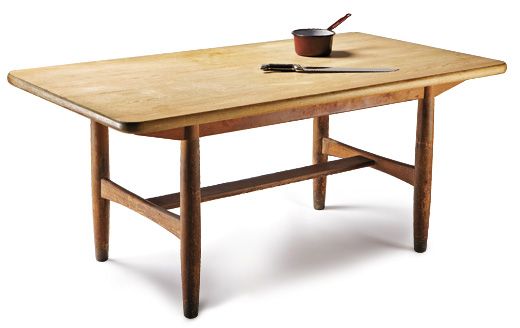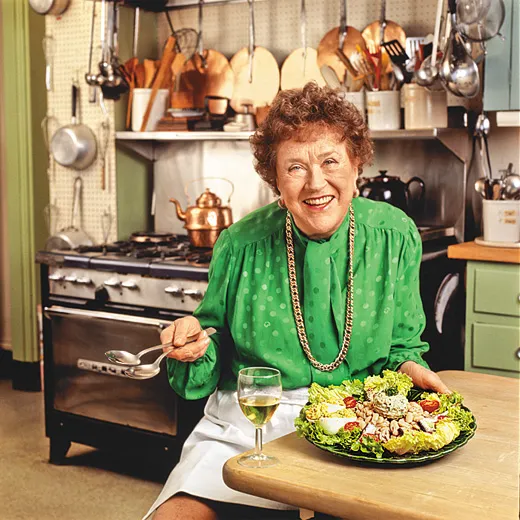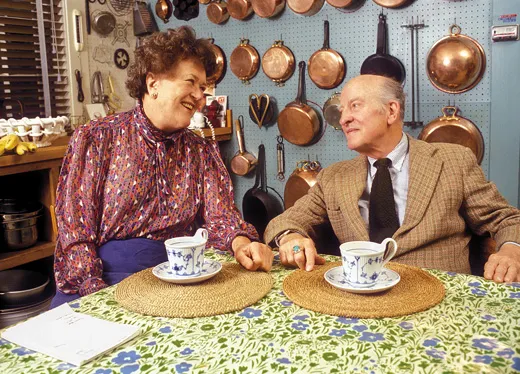Julia Child’s Recipe for a Thoroughly Modern Marriage
Food writer Ruth Reichl looks at the impact of the famous chef’s partnership with her husband Paul
/https://tf-cmsv2-smithsonianmag-media.s3.amazonaws.com/filer/Julia-Childs-Kitchen-631.jpg)
By the time I met Julia Child, her husband, Paul, was little more than a ghost of a man, so diminished by old age and its attendant diseases that it was impossible to discern the remarkable artist, photographer and poet he once had been. It broke my heart, because the more I knew Julia, the more I wished I had known Paul. “He’s responsible for everything I did,” she once told me. When I look at Julia’s kitchen, it is Paul who comes to mind.
“For us the kitchen is the soul of our house,” she told the Smithsonian curators who traveled to her home in Cambridge, Massachusetts, as her kitchen was being packed up for the National Museum of American History in 2001. She spoke as if her husband were still alive, although by then he had been gone for more than seven years. That reminded me of what it was like to spend time with Julia, how it always seemed as if Paul were in the next room, that he would appear at any minute, pull up a chair and join you at the table.
“If we could just have the kitchen and the bedroom, that would be all we need,” she told the curators wistfully, and listening to that I felt a thrill of recognition, for that one sentence tells you everything about the woman who changed the way America cooks. Until she met her future husband, Julia had never given much thought to food (on her own she made do with frozen food). She learned to cook to please Paul, attempting to seduce him with her kitchen prowess; she liked to tell the story of how she had, in her early attempts at cooking, exploded a duck and set the oven on fire.
Much later Julia said she wished she’d started cooking at 14, but that was never in the cards. Girls of her class did not cook—there were servants to do that—and they certainly did not do it professionally. “Middle-class women did not have careers,” Julia said.“You were to marry and have children and be a nice mother. You didn’t go out and do anything.”
At 6-foot-2, however, husbands were not easy to find, and after graduation from Smith College, Julia McWilliams ended up in New York, sharing an apartment with two friends, writing ad copy. “I was a Republican until I got to New York and had to live on $18 a week,” she said. “It was then that I became a Democrat.”
When her mother fell ill, Julia dutifully returned to Republican Pasadena, California, keeping house for her father. She played a great deal of golf and joined the Junior League. For someone with her drive, intelligence and energy, this little life must have been a nightmare, and when the war came along she happily joined the OSS, propelled as much by boredom as by patriotism. By then she was already in spinster territory—the dread 30s. Although she lamented to a friend that she had never been a spy (merely “in charge of all the files”), the posting to Ceylon must have seemed like a ticket to adventure.
But the real adventure began when she met Paul. It changed her life—and, by extension, ours. It was her passion for French food that initially enthralled us, but I have no doubt that if the State Department had posted Paul and his new wife to Rome instead of Paris, she would have taught us spaghetti instead of soufflés. Paul loved highly spiced and garlicky dishes, and she was never one to do things by half measures.
She enrolled in a professional cooking school—the Cordon Bleu—and then started a school of her own. “I have,” she said with remarkable prescience in 1952, “finally found a real and satisfying profession which will keep me busy well into the year 2,000.” Exhilarated by her new career, she set about writing a book that would “make cooking make sense.”
In one of the greatest blunders in publishing history, Houghton Mifflin rejected the book as “too formidable.” It was an enormous blow. By the time Paul left the diplomatic corps in 1961, she had been working on what would become Mastering the Art of French Cooking for nine years, and the couple moved into their new house in Cambridge with little money and few expectations. “We shall,” Julia told a friend, “be living quite modestly. But I figure if I can give 2 cooking lessons a week at about $40 a throw, that will bring in a tidy sum.”
To save money, Paul designed the kitchen himself. Mindful that his tall wife had been stooping in their tiny European kitchens (a picture he took in their Paris kitchen shows her stirring a pot almost at the level of her knees), Paul raised the counters. Aware of her passion for order, he figured out the perfect place for every pot and pan and drew its outline on the pegboard; a blind person could cook in this kitchen. “I like things to hang up,” Julia said, “so Paul made a diagram of where everything goes. It’s nice to have them back where they belong.” He moved a used professional Garland stove (purchased for $429) into the kitchen, and arranged Julia’s knives on magnetic strips so she could grab one without scrabbling through a drawer. “It’s very important that you train yourself with your knives,” she said. “Once you’ve used it and washed it, you put it away.”
An admitted knife-freak, Julia had dozens, most of them well used. But the one here, which she called her “fright knife,” was mainly a prop. “I love great big things,” she always said, and she certainly understood how hilarious that big knife looked when she brandished it on television. “Doing television,” she said, “you want amusing things, something fun and unusual. I think also on the television you want to do things loud; people love the whamming noises.”
It was this instinct that got Julia on the air in the first place. Invited to appear on a book review show called “I’ve Been Reading,” she showed up at the WGBH studios with a hot plate, some eggs and a giant whisk, and whipped up an omelet for the startled host. The audience begged for more—and got it; over the next three years the station produced almost 200 shows and turned Julia Child into a national icon.
Working nearly until her death at almost 92, Julia went on to produce a stunning number of books and television shows. She is largely responsible for the fact that food is now part of American popular culture, and although she passed away in 2004, her influence keeps growing. A whole new generation fell in love when Meryl Streep played her in the movies.
Part of Julia’s appeal was that she was so down-to-earth. Although she had a battery of heavy copper pots (purchased at Paris’ legendary Dehillerin), Julia preferred a little enamel saucepan that she used for 50 years. I once asked her about her favorite frying pan, and she pulled out an ordinary no-stick aluminum pan. “You get it at the hardware store,” she said. “It’s perfect for omelets. I could not live without that.”
When she said that she was sitting at her handsome Norwegian table in the center of the kitchen. Julia usually kept it covered with a yellowish orange and white-striped Marimekko cloth, and on top of that was a sheet of plastic; it made it easier to clean. Although the house also had what she called a “beautiful, big dining room,” it was the kitchen where Julia most often entertained you. And if you were very lucky, you’d look underneath the table to find a hidden message.
One mischievous morning Paul, an incurable lover of bananas, peeled off a couple of stickers and left them, the sly signature of a man who had no need to make a public mark.
Paul Child was 60 years old when he retired to Cambridge. He could, according to his besotted wife, “do just about anything, including making a French-type omelet. Carpenter, cabinet-builder, intellectual, wine-bibber, wrestler. A most interesting man and a lovely husband.” Up to this point in their union, his career had dominated their lives as Julia followed him from one State Department posting to the next. His intention, on coming home, was to retire into the world of art and do the work he loved best.
But after the success of Julia’s book, the two reversed roles and he threw himself into her life with the same enthusiasm with which she had shared his. In a letter to his brother he wrote, “How fortunate we are at this moment in our lives! Each doing what he most wants, in a marvelously adapted place, close to each other, superbly fed and housed, with excellent health....”
That attitude was, for its time, truly remarkable. Mastering was published just a couple of years before The Feminine Mystique. Women all over America were feeling oppressed—and with good reason. I cannot count the women of my mother’s generation who paid heavily for their success. Their husbands resented it; their children did too. But Paul Child was a supremely confident man. “Whatever it is, I will do it,” he told Julia, becoming her manager, photographer, recipe-tester and taster, proofreader, illustrator. When she went on the road to promote her books, he went along. Few men of Paul Child’s generation would have been able to enjoy their wife’s success as he did.
And so when I look at this kitchen, I see more than just the practical simplicity that immediately meets your eye. And I see more than the place that welcomed so many Americans into the joys of cooking. When I look at this kitchen I see the legacy of a remarkable couple who were not only creating a food revolution, but also redefining what a modern marriage might be.


